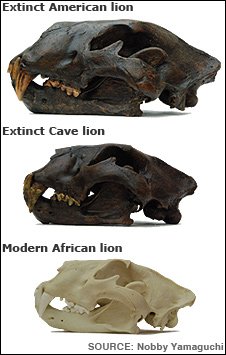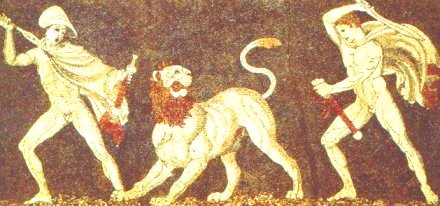Ancient Lions Lived Late
Posted by: Loren Coleman on April 2nd, 2009

BBC News carried an article on March 31, 2009, about a subject of much interest to cryptozoologists, the late survival of ancient lions. We have discussed these fossil members of Felidae here, especially with regard to the American lion, Panthera atrox. As the accepted and acknowledged time window when they lived slowly creeps closer, perhaps someday zoology, with an assist from cryptozoological findings, might be talking more openly about the historical survival of these large felids.
Giant lions were roaming around Britain, Europe and North America up to 13,000 years ago, scientists from Oxford University have found.
Remains of giant cats previously discovered were thought to be a species of jaguar or tiger but after DNA analysis they were proved to be lions.
They were 25% bigger than the species of African lion living today, and had longer legs to chase their prey.
They would have lived in icy tundra with mammoth and sabretooth tigers.It is thought these animals would hunt over longer distances, and their longer legs would help them chase down their prey as opposed to the modern-day species which tends to ambush its victims.
The Oxford team analysed DNA from fossils and other remains gathered from Germany to Siberia, and Alaska to Wyoming.
Lions appear to have been very important to early man with many depictions of them in their cave paintings, as in seen in the pre-historic cave complex at Chauvet in France.
Other archaeological finds in Germany include figurines which are half man, half lion, leading to the theory that lions may even have been worshipped by ancient humans.
The team found that these remains from the Pleistocene Epoch (1.8 million years ago to 10,000 years ago) could be divided into two groups: the American Lion which lived in North America, and the Cave Lion which lived in northern Europe, Russia, Alaska and the Yukon.
These ancient cats would have lived in an environment that was more like an icy tundra and would have shared their habitat with herds of other large animals such as mammoth, woolly rhino, sabre tooth tigers and giant deer.
About 13,000 years ago these species died out in a mass extinction. Figuring out the reason behind this, Dr. [Ross] Barnett said, was one of the last great scientific mysteries.
by Natalie Hancock, BBC News

Alexander and Craterus fighting a lion. Alexander went on two such hunts, the Sidonian lion hunt (in Phoenicia, 332 BC) and the lion hunt in Basista (a.k.a. Bazaira, Sogdiana, in 328/327 BC). Herodotus recorded how Xerxes’ Persian invasion army of 480 BC was attacked by lions while camped on the eastern fringes of Greece and Macedonia. (See Mysterious America for an entire chapter on this.)
Dr. Ross Barnett, who conducted the research at Oxford University’s department of Zoology, said:
These ancient lions were like a super-sized version of today’s lions and, in the Americas, with longer legs adapted for endurance running.
What our genetic evidence shows is that these ancient extinct lions and the lions of today were very closely related. Cave art also suggests that they formed prides, although the males in the pictures would not have had manes and they are depicted very realistically.
There are a couple of different schools of thought. It could have been climate change or something to do with humans.
Humans could have been killing off their prey or killing the lions themselves. The extinction is a big question that remains unresolved. More research and more advanced genetic analysis may help answer it.
Ah, the blog is back, and it’s important that you keep this research going and save the museum…please
About Loren Coleman
Loren Coleman is one of the world’s leading cryptozoologists, some say “the” leading living cryptozoologist. Certainly, he is acknowledged as the current living American researcher and writer who has most popularized cryptozoology in the late 20th and early 21st centuries.
Starting his fieldwork and investigations in 1960, after traveling and trekking extensively in pursuit of cryptozoological mysteries, Coleman began writing to share his experiences in 1969. An honorary member of Ivan T. Sanderson’s Society for the Investigation of the Unexplained in the 1970s, Coleman has been bestowed with similar honorary memberships of the North Idaho College Cryptozoology Club in 1983, and in subsequent years, that of the British Columbia Scientific Cryptozoology Club, CryptoSafari International, and other international organizations. He was also a Life Member and Benefactor of the International Society of Cryptozoology (now-defunct).
Loren Coleman’s daily blog, as a member of the Cryptomundo Team, served as an ongoing avenue of communication for the ever-growing body of cryptozoo news from 2005 through 2013. He returned as an infrequent contributor beginning Halloween week of 2015.
Coleman is the founder in 2003, and current director of the International Cryptozoology Museum in Portland, Maine.










I believe there’s enough difference between these cats to warrant separation at the species level. I’ll go for Panthera atrox but not Panthera leo atrox. I also think that the Asiatic “subspecies” should be recognized as a separate species.
Great Post! Love info on ancient cats. Just think: hearing a noise outside the hut and thinking is it a raccoon OR A 8 foot long hungry lion. Honey could you get up and scare away that damn coon.
I noticed this in the newsfeeds, and just knew you’d be picking up on it, Loren. Very interesting. Keep up the good work guys.
Very interesting stuff.
Coming on the heels of PBS’s science program, NOVA, a few nights ago in which the theory of the pleistocene extinction is considered in light of the recently revealed evidence of impact by cosmic bollide approximately 13 thousand years ago, news like this is doubly intriguing.
My contention is that lions, like any predator exists in relationship to the size and abundance of its prey. Grazing animals evolutionary strategy can take several pathways but if there is food enough, increased size will confer an advantage and so we see really big animals in the context of big areas of open and mixed grasslands. Our current planetary ecology, while it seems like the status quo, is in fact a gap from what would be the normally expected climate of ice ages which in fact have dominated our terrestrial ecology for most of the last couple of million years. These ice ages, while commonly thought of a impinging on habitat overall, also created what had to be one of the largest contiguous mosaic of non-forested habitats possible; a zone of grassland, steppe, tundra and cold desert, ideal for adapted grazers and browsers that would have reached from Europe, across Asia and Beringia (now submerged) all the way to the Eastern US.
The current context in which we think of lions and other creatures including our own ancestors is formed mainly by how historians have interpreted what was conservatively known with a reasonable degree objective certainty. Well, a lot has been discovered since we were all in school reading history on wax tablets and much of that has not yet been incorporated into the general understanding, but thanks to info such as this, we’re beginning to awaken to it.
The thing I noted in all this was that these lions had little or no manes. Couple that with the thought that they may have somehow survived the Pleistocene and been or became melanistic and voila! you have a possible explanation for all these darn black panther sightings. Not quite sure I’m ready to buy that yet, but hey, it’s another piece of the puzzle that may be in favour of such a supposition.